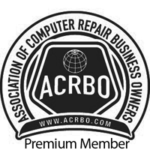Hello everyone,
The very first thing that I do when I repair a computer is to check the state of the Hard Drive. I didn’t always do this and I had to learn the hard way. You can imagine what it’s like to start cleaning and optimizing a computer (remove junk files, remove unneeded programs, install needed programs, scan for malware, defragment the hard drive, run chkdsk, etc.), only to find out that you are dealing with a defective hard drive. Since the drive is in a bad state it could die at any moment, especially if it continues to be stressed by any or all of the aforementioned.
These are the two great software tools that I use to check the state of a hard drive:
1) CrystalDiskInfo:
CrystalDiskInfo is “a HDD/SSD utility software which supports S.M.A.R.T. and a part of USB-HDD”. It’s incredibly easy to download, install, and run. It will immediately tell you whether the condition of the hard drive is BAD (red color), CAUTION (yellow color), or GOOD (green color). If CrystalDiskInfo reports a yellow caution or worse, you had better stop what you are doing and back everything up as soon as possible. It’s only a matter of time before your hard drive “goes south” (although it could still function for weeks or months).
2) SeaTools:
To give myself a second opinion I download, install, and run SeaTools by Seagate.
“SeaTools is a comprehensive, easy-to-use diagnostic tool that helps you quickly determine the condition of the disk drive in your external hard drive, desktop or laptop computer. It includes several tests that will examine the physical media on your Seagate or Maxtor disk drive and any other non-Seagate disk drive”.
After running CrystalDiskInfo and SeaTools I have a very good idea as to whether the hard drive is very defective, somewhat defective, or not defective at all. I can then communicate this information to the client and proceed accordingly.
Professor Randy says: Don’t do any kind of computer repair without first checking the current state of the Hard Drive. By doing this you will avoid a lot “heartache” further on down the line! Use these two simple tools to give you a better idea of what’s going on with your drive.




11:56 pm on February 20th, 2012 1
Bad hard drives are VERY prevalent in laptops, its the first thing I check every time. Even with all the advances they’ve made with head parking and vibration detection, bang your laptop on a desk or even a knee at the wrong time….
11:57 pm on February 20th, 2012 2
Had to post a follow up, don’t waste your time with short/quick tests, I have run into many times where the short test found nothing but the long tests finds errors.